Living fences combine boundary-making with food production by growing edible plants vertically. You’ll maximize space by training fast-growing climbers like cherry tomatoes and cucumbers on sturdy trellises or bamboo frames. Plant in well-draining soil, water consistently (1-2 inches weekly), and maintain regular pruning schedules. These edible barriers offer climate protection, attract beneficial insects, and require less maintenance than traditional fencing. The following guide reveals how to design a productive living fence that provides harvests throughout the growing season.
11 SECOND-LEVEL HEADINGS
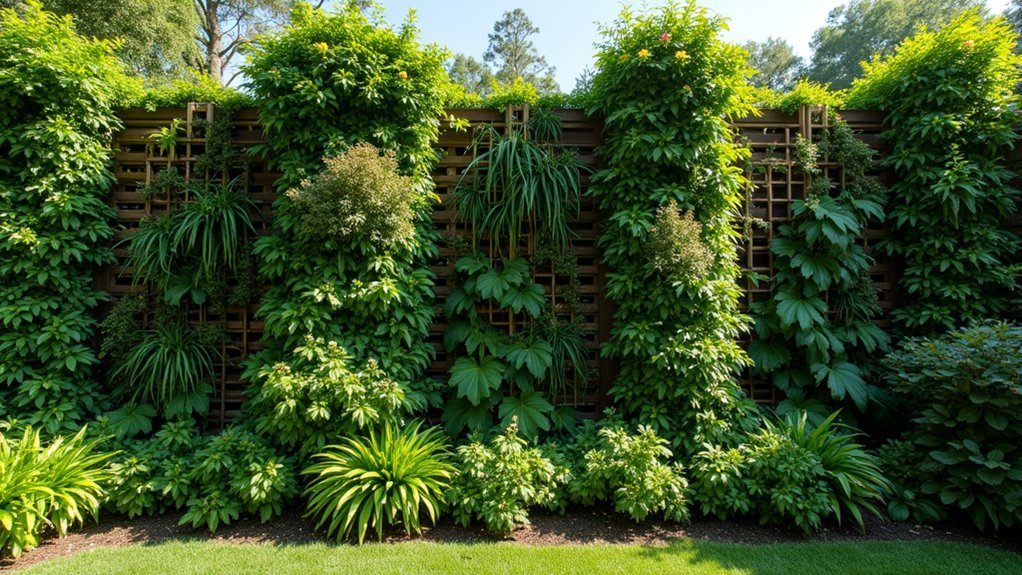
When designing your living fence, you’ll need to organize your approach with clear second-level headings that address specific aspects of the project.
Consider categories like “Plant Selection,” where you identify climbing vegetables such as cherry tomatoes and green beans that thrive in your growing conditions.
Include “Support Structures” to detail the trellises and grids needed for plants to climb effectively.
Add “Soil Requirements” to emphasize the importance of well-draining soil for peak growth.
“Maintenance Schedule” helps track regular pruning to maintain shape and foster healthy development.
Don’t forget “Companion Planting,” which can highlight how herbs like basil and rosemary attract beneficial pollinators while adding culinary value.
These organized sections will guarantee your vertical garden succeeds as both a privacy screen and edible landscape.
The Sustainable Advantage of Edible Living Fences
Edible living fences offer you remarkable resource efficiency, creating natural boundaries while producing food without additional land requirements.
You’ll find these green barriers provide excellent climate protection, shielding your garden from harsh winds and temperature fluctuations while sequestering carbon.
These productive boundaries require minimal upkeep compared to traditional fencing, allowing you to harvest fresh produce throughout growing seasons with less effort than conventional gardening methods.
Resource-Efficient Boundary Systems
Beyond mere aesthetics, living fences with edible components represent one of the most resource-efficient boundary systems available to today’s gardeners. You’ll conserve water and space while producing food and supporting local ecosystems.
| Resource Benefit | Living Fence Advantage |
|---|---|
| Water Usage | Reduces irrigation needs through shared root systems |
| Space Efficiency | Maximizes vertical growing area on property edges |
| Biodiversity | Attracts pollinators and beneficial insects naturally |
| Maintenance | Requires less chemical inputs than traditional gardens |
Climate Impact Protection
As our planet faces mounting climate challenges, edible living fences offer a remarkably effective solution that goes far beyond traditional landscaping. By growing tomatoes, beans, and native edible plants vertically, you’re actively sequestering carbon while maximizing your growing season.
These living boundaries create natural cooling zones that reduce energy costs and mitigate urban heat island effects around your property.
- Transform your boundary into a carbon-capturing ecosystem that produces food while fighting climate change
- Create microclimate buffers that naturally cool your home, reducing air conditioning needs and energy consumption
- Improve soil resilience through better water retention and erosion control, essential adaptations for changing weather patterns
Your edible fence becomes both a food source and climate solution, working year-round to protect your local environment.
Low-Maintenance Food Production
Unlike traditional gardens that demand constant attention, edible living fences transform your property boundaries into self-sustaining food systems that work with nature, not against it.
By integrating perennials like strawberries with herbs such as rosemary and basil, you’ll create low-maintenance food production that delivers harvests year after year with minimal intervention.
Your vertical garden maximizes space efficiency while naturally attracting pollinators and beneficial insects that help control pests.
This biodiversity boost means less time fighting garden problems and more time enjoying fresh cherry tomatoes and green beans straight from your fence.
Regular pruning not only maintains your living fence’s appearance but actually increases fruit production.
You’ll harvest more food from less space while creating privacy and beauty—a practical solution for sustainable living.
Selecting Climbers: Best Plants for Vertical Fence Systems
When planning your living fence, you’ll want to prioritize fast-growing climbers like cherry tomatoes, cucumbers, and pole beans that maximize vertical space while providing abundant harvests.
These climbing vegetables thrive when supported by proper trellising systems that can be seasonally adjusted to accommodate their growth patterns and weight as they mature.
You can easily create effective supports by attaching sturdy wire grids or natural bamboo frames to existing fencing, ensuring your climbing edibles receive the 6-8 hours of sunlight they need for ideal production.
Climbing Vegetables Worth Growing
Vertical fence systems transform ordinary garden boundaries into productive growing surfaces for climbing vegetables. Your fence becomes both a space-saving solution and a living pantry when you grow peas and pole beans that thrive with 6-8 hours of sunlight.
Cucumbers perform exceptionally well on trellises attached to fences, needing just 1-2 inches of water weekly for abundant harvests.
- Fast-growing climbing plants like squash and melons quickly transform bare fences into lush, productive walls that double as attractive landscape elements.
- Companion planting basil near your vertical vegetables naturally deters pests while enhancing growth and flavor.
- Utilizing existing fencing organizes your garden layout, conserves resources, and makes harvesting easier.
Seasonal Trellising Techniques
The right climbing plants transform ordinary fences into productive vertical gardens throughout the growing season. Fast-growing varieties like cherry tomatoes and green beans excel in zones 2-10, needing 6-8 hours of daily sunlight to thrive vertically.
When growing vegetables on a fence, install sturdy trellises against existing structures like wood or chain-link fencing. For summer harvests, train cucumbers and pole beans upward to minimize ground contact, reducing pest issues and disease spread.
In lower sections, incorporate basil and rosemary in well-draining soil with 6.0-7.5 pH as attractive, useful fillers.
Don’t overlook strawberries for year-round interest—these perennials work beautifully in hanging baskets or wall-mounted planters, attracting pollinators while producing fruit for multiple seasons with minimal ground space.
Structural Support Options for Your Living Fence

Building a successful living fence depends greatly on choosing the right structural supports for your plant selections.
Transform existing barriers into productive green barriers by using chain-link or wooden fencing as vertical supports for climbing vegetables. For solid wood fences, attach trellises or grids to create organized support systems that maximize both space and aesthetics. Cement walls can become growing spaces when you add planter boxes to their flat surfaces, perfect for herbs and compact plants.
- Confirm all structural supports can bear the weight of fully mature plants plus the force of wind and rain
- Inspect your supports regularly throughout the growing season to prevent collapse during peak production
- Consider the height of your fence in relation to sunlight patterns to optimize plant growth
Season-by-Season Planting Guide for Continuous Harvests
Your living fence can transform into a year-round garden with strategic seasonal planting.
Start your spring with quick-growing cherry tomatoes and green beans. Shift to heat-loving herbs like basil and rosemary during summer, then switch to hardy greens and root vegetables as fall approaches.
You’ll maximize your harvests by utilizing vertical space with trellises and maintaining a staggered planting schedule that guarantees continuous production throughout the growing season.
Spring Awakening Strategies
As winter retreats and soil temperatures rise, springtime offers the perfect opportunity to establish your living fence’s foundation for year-round harvests.
Focus on fast-growing climbers like green beans and cherry tomatoes that grow well in zones 2-11 with 6-8 hours of sunlight. Train these vigorous plants on trellises to maximize your vertical space while guaranteeing proper air circulation.
Plant herbs such as basil and rosemary in lower sections where they’ll thrive in well-draining soil with pH 6.0-7.5, providing continuous harvests for your kitchen throughout the season.
- Implement staggered planting schedules to guarantee crops mature at different times
- Prepare soil with proper amendments before the growing season begins
- Position climbing varieties strategically where they’ll receive ideal sunlight exposure
Summer Heat Management
When temperatures soar during summer months, your living fence requires thoughtful management strategies to maintain productivity and health.
Focus on heat-tolerant varieties like cherry tomatoes and green beans, which thrive in full sunlight and continue producing throughout the season.
Apply mulch around your living fence plants to retain moisture in well-drained soil, suppress weeds, and moderate soil temperatures.
This simple technique protects roots during intense heat waves.
Train climbing vegetables such as pole beans and cucumbers vertically on trellises attached to your fence.
This maximizes space while improving airflow, reducing heat stress on plants.
Maintain consistent watering of 1-2 inches weekly, adjusting for increased evaporation.
Complement your design with heat-loving herbs like basil and rosemary, which provide shade and attract beneficial insects to support your living fence ecosystem.
Fall-Winter Succession Planning
Successful living fences deliver harvests year-round through strategic succession planting that maximizes each season’s potential.
As summer wanes, transform your living fence into a fall-winter powerhouse by introducing cold-hardy vegetables like kale, spinach, and Brussels sprouts. These resilient plants thrive when temperatures drop, extending your productive season well into winter.
- Protect your best living fence investments with row covers and cloches, allowing tender greens to flourish despite early frosts.
- Plant winter cover crops such as clover or rye between harvested sections to nourish soil and prevent erosion.
- Start spring seedlings indoors during late winter while maintaining a staggered planting schedule to guarantee continuous yields.
Don’t let your living structure go dormant—with proper succession planning, your edible boundary can produce food through every season.
Pruning Techniques to Maximize Yield and Fence Density
Regular pruning forms the backbone of a thriving living fence, encouraging both density and productivity throughout the growing season.
You’ll want to schedule pruning 1-2 times annually, using sharp, clean tools to shape your fence while avoiding late-season cuts that stress plants.
Creative pruning techniques like topiary and espaliering not only enhance aesthetic appeal but strategically direct vertical growth, improving light penetration and air circulation.
This approach maximizes your growing space while maintaining structural integrity.
When pruning climbing varieties such as tomatoes and beans, guide their growth along supports to optimize sunlight exposure.
Remember that thoughtful pruning can facilitate companion planting relationships, where neighboring plants benefit each other.
Integrating Multiple Plant Layers for Complete Coverage
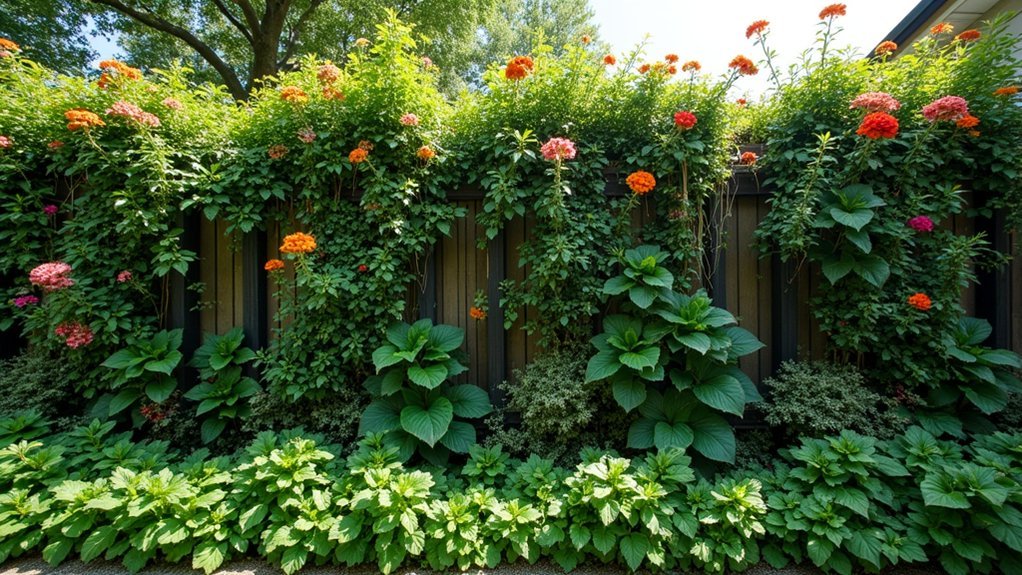
A robust living fence depends on strategic layering, where multiple plant varieties work together for complete coverage from ground to sky.
Position tall climbers like pole beans at the top, medium shrubs like rosemary in the middle, and ground-covering strawberries at the base. This vertical integration maximizes your growing space while ensuring each plant’s root systems don’t compete excessively for nutrients.
When designing your layered fence, remember to:
- Place taller plants on the north side so they won’t shade shorter varieties
- Combine companion plants like basil and tomatoes that naturally deter pests for each other
- Include both fast-growing annuals and sturdy perennials for year-round structure
You’ll need to prune regularly to maintain balance between layers, preventing aggressive growers from dominating while ensuring your fence remains both productive and visually appealing.
Designing for Both Privacy and Productivity
While most homeowners think they must choose between beauty and utility, the ideal living fence serves both purposes simultaneously. Your living barrier can provide essential privacy while yielding fresh produce throughout the growing season.
Maximize vertical space by training fast-growing climbers like green beans and cherry tomatoes along trellises or existing fence structures. Make certain these plants receive adequate sunlight and air circulation to thrive.
Create visual interest by incorporating layers—taller privacy plants in the background with lower-growing herbs like basil and rosemary at the front.
Include native species alongside your edibles to support local biodiversity while maintaining the privacy function.
Regular pruning is crucial not only for maintaining your fence’s shape and density but also for making certain sunlight reaches all plants, optimizing both privacy coverage and food production.
Combating Common Pests in Vertical Garden Systems
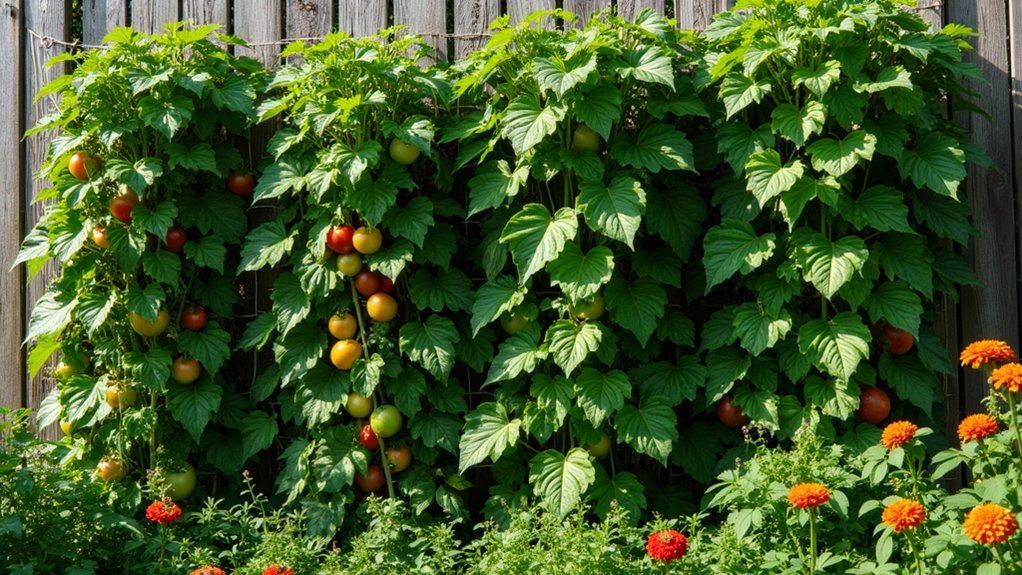
Successful vertical gardens can quickly become vulnerable ecosystems once pests discover your living fence. Implement an integrated approach by planting natural pest deterrents like marigolds around the base of your structure.
These decoy plants distract aphids and voles from your primary crops while attracting beneficial insects like ladybugs that devour unwanted pests.
Regular inspection is your best defense—catch problems early by examining leaves and stems weekly. When you spot trouble, reach for organic treatments such as neem oil that target pests without harming helpful insects.
- Create a resilient ecosystem by pairing companion plants strategically throughout your vertical space
- Maintain healthy soil through composting—robust plants naturally resist pest attacks
- Install physical barriers like insect netting that protect crops while allowing sunlight and rainwater access
Water Management for Thriving Fence Plantings
Because living fences depend on consistent moisture to establish strong root systems, proper water management becomes your foundation for success.
Strategic placement of swales can direct water flow to your fence line, especially on sloped terrain or in areas with clay soil.
Install rain gardens near downspouts to capture runoff, retaining water on-site and recharging aquifers to sustain plants during dry spells.
Apply an 8-10 inch layer of mulch over a cardboard base to lock in moisture, suppress weeds, and stabilize soil temperature. This combination creates ideal conditions for young plants as they develop.
Remember to monitor moisture levels regularly. Your living fence may need consistent watering for the first few years until established.
Thoughtful water management now guarantees a thriving, self-sustaining boundary for decades.
Harvesting Tips: Maintaining Your Living Fence While Gathering Food
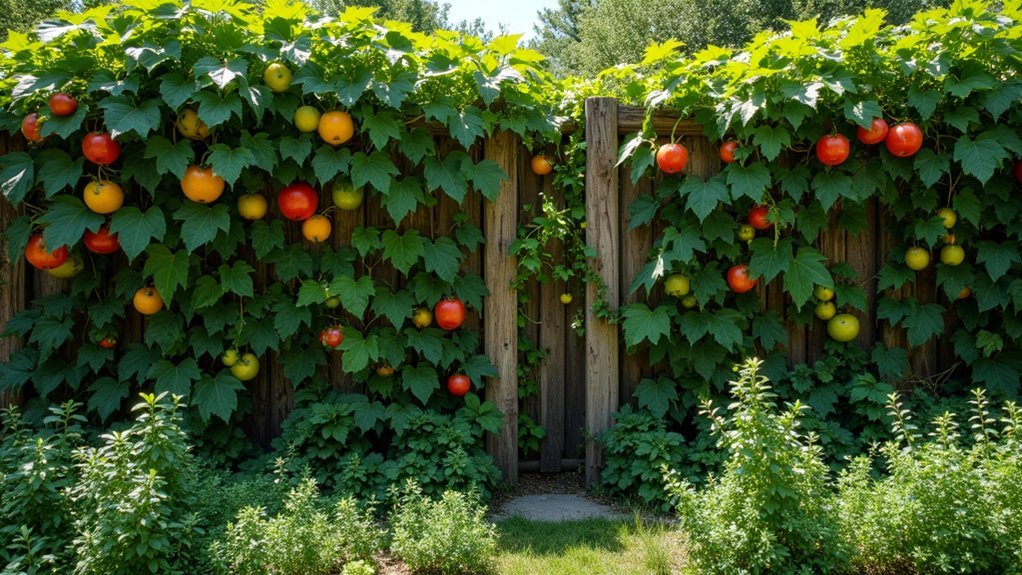
As your living fence matures into a productive ecosystem, balancing maintenance with harvest becomes an essential skill. Regular pruning 1-2 times yearly encourages dense growth while making harvesting easier.
The delicate dance of pruning and picking transforms your fence from mere boundary to thriving pantry.
When gathering food, check for signs of pests or disease—early detection helps protect your entire fence. Remember that proper sunlight exposure (6-8 hours daily) and consistent watering (1-2 inches weekly) maximize your yield.
- Use vertical trellises for climbing vegetables like cucumbers and beans to simplify harvesting and strengthen your fence structure
- Implement companion planting strategies—like pairing basil with tomatoes—to enhance flavors and naturally deter pests
- Harvest during early morning hours when plants are most hydrated and flavors are at their peak
Frequently Asked Questions
How Much Does a Living Fence Cost?
Your living fence costs typically range from $10-$30 per linear foot initially, plus annual maintenance of $100-$300. You’ll save long-term compared to traditional fencing, especially if you choose hardy native plants.
What Is the Best Plant to Grow up a Fence?
Climbing plants like green beans and peas are your best options for growing up a fence. They’ll quickly cover vertical structures while providing food. Cherry tomatoes also work well if you want juicy fruits.
What Are the Disadvantages of a Life Fence?
You’ll face several disadvantages with living fences: they take 2-5 years to establish, require regular pruning, may include invasive species, compete with nearby crops for nutrients, and can harbor pests and diseases.
How Long Does a Living Fence Take to Grow?
Your living fence will take 2-5 years to establish fully. You’ll see faster results with species like Thuja ‘Green Giant’, but growth depends on your care, soil conditions, and the plant varieties you’ve chosen.
In Summary
By creating your edible living fence, you’ve embraced a solution that offers privacy, beauty, and nutrition in one package. You’ll enjoy fresh harvests while contributing to sustainability in your landscape. As you tend to your vertical garden throughout the seasons, you’re not just growing food—you’re cultivating a productive boundary that connects you to nature’s rhythms right in your own yard.

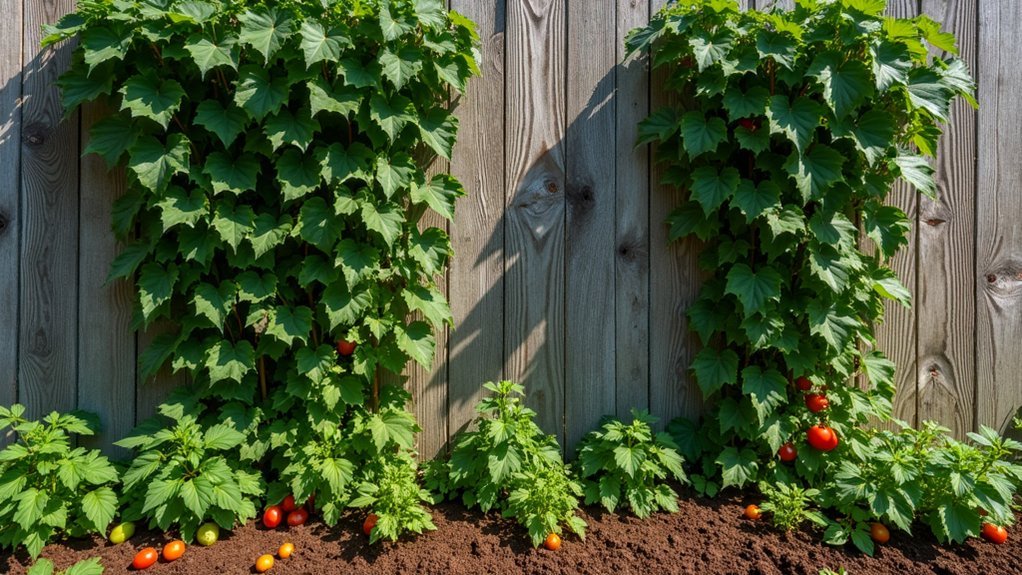



Leave a Reply